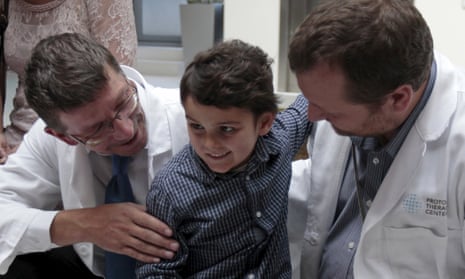Proton beam therapy causes fewer severe side effects in child cancer patients than conventional radiotherapy, a study has found.
Researchers said common toxic effects of photon-based radiotherapy on the heart, lungs and stomach were not seen in patients who received proton treatment.
The study, published in the Lancet Oncology journal, said the two types of treatment had similar survival rates for young people with the rare brain tumour medulloblastoma.
The alternative treatment came to public attention after Brett and Naghmeh King took their son Ashya out of a British hospital and travelled to the Czech Republic for proton therapy, which was not initially offered to them on the NHS.
The study, led by Massachusetts General hospital, said: “Our findings suggest that proton radiotherapy seems to result in an acceptable degree of toxicity and had similar survival outcomes to those achieved with photon-based radiotherapy.
“Although there remain some effects of treatment on hearing, endocrine and neurocognitive outcomes – particularly in younger patients – other late effects common in photon-treated patients, such as cardiac, pulmonary and gastrointestinal toxic effects, were absent.
“Proton radiotherapy resulted in acceptable toxicity and had similar survival outcomes to those noted with conventional radiotherapy, suggesting that the use of the treatment may be an alternative to photon-based treatments.”
The study analysed 59 patients aged between three and 21 from 2003-09. Of these, 55 had the tumour partially or completely removed through surgery, while all patients received chemotherapy as well as proton beam therapy. Three years after treatment, 83% survived without the cancer getting worse, falling to 80% after five years.
In terms of side effects, around one in seven had serious hearing loss after five years and more than half (55%) had problems with the neurendocrine system, which regulates hormones.
Proton therapy is a highly targeted treatment often used on hard-to-reach cancers and has a lower risk of damaging other body tissue.
The Kings sparked an international search when they took Ashya, then aged five, from Southampton General hospital without doctors’ consent in August 2014.
The couple were arrested a few days later in Spain, where they were forced to spend several nights in prison away from their son before being released. The boy is expected to make a full recovery and returned to school full-time this month.
Proton therapy was not offered to Ashya on the NHS, although the health service later agreed to fund his treatment. Several new proton beam therapy centres will open in the UK from this year.
